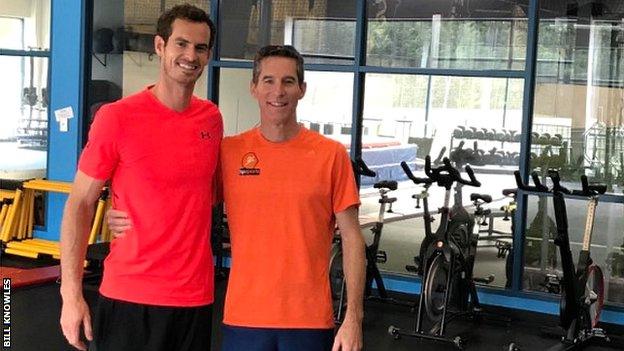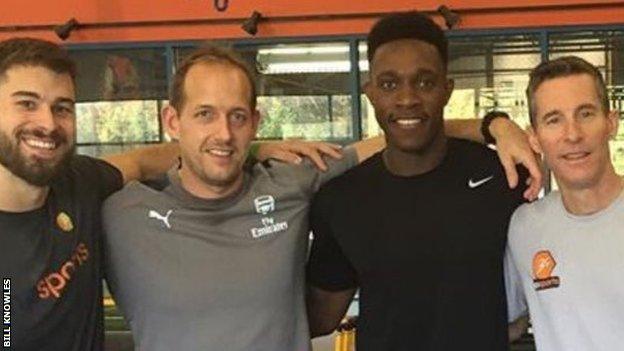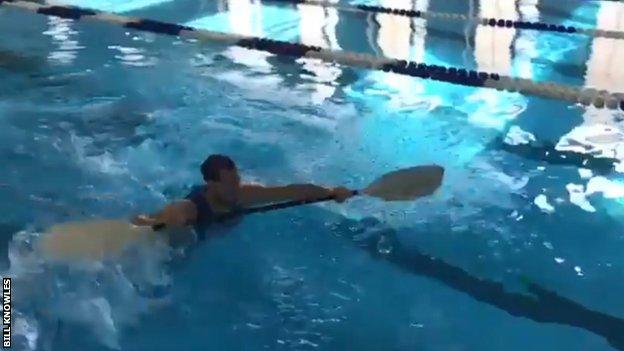Andy Murray: How the Scot is using handstands to gear up for the new season
- Published
Why is Andy Murray doing cartwheels?
When Andy Murray published a video of a recent gym session during which he did a handstand, fellow tennis player Nick Kyrgios responded: "I see you've lost your marbles without me."
It seemed an unorthodox way to prepare for the new season, as the Scot continues his long road back from hip surgery last January.
But the coach making Murray leap and bound all over his Philadelphia gym has become a go-to man for sportspeople returning from serious injury.
Bill Knowles was one of the first people to text Danny Welbeck after he broke his ankle last month, having previously worked with the England footballer.
Callum Wilson - another England player - had so much faith in Knowles' methods he missed the birth of his second child.
So why do the stars seek the American's wisdom, and why is he seemingly turning them into acrobats?
Handstands, trampolines and 'athletic normal'
Murray posted the video of his gym session on Instagram with the caption "never grow up" - and given he played in just six tournaments this year, you can hardly blame him for having some fun.
Bounding off trampolines and performing cartwheels may look like a scene from a soft-play centre, but gymnastics is a key part of getting the likes of Murray back to what Knowles describes as 'athletic normal'.
Knowles, who calls himself a "reconditioning specialist", says he is setting physical puzzles for the body, in the same way a crossword keeps the brain in shape.
"Athletic normal is a place where you can express all types of movement literacy - such as jumping, skipping, falling, stepping or lunging - without reservation and especially without pain," the 53-year-old told BBC Sport.
"You could push weights above your head to build shoulder strength or core stability, but a handstand does all of those things and there is still a level of apprehension that we try to break down.
"The approach is a lot of fun and when you're in good spirits and excited about training, you move better, anticipate pain less and recover faster. It's very motivating."
Judy Murray - who saw Knowles in action during her son's seven-week stay - agrees.
"Andy was learning so many new things and I've never seen him do a handstand or a cartwheel before," she told BBC Radio 5 live. "That gets you street cred with your kids, doesn't it?"

Andy Murray visited Bill Knowles for seven weeks to help his reconditioning programme
The injury or sport doesn't matter
Knowles says he works on "fundamental principles of sports movements", which mean the injury "and to a large degree" sport do not matter.
Among his previous clients are ex-England footballers John Terry, Frank Lampard and Michael Owen, and World Cup-winning former England rugby union player Jonny Wilkinson.
Unlike some fitness specialists, he works in conjunction with physiotherapists and sports scientists already in place to get the athlete back on track.
Knowles, who also works with the youth teams at MLS side Philadelphia Union, said: "It's really about building confidence to a point where they can express the skill that has made them world-class."
Murray said: "Bill is very out the box and has an American can-do attitude. He has no fear of trying new things and has worked with so many top athletes, so even though he may not have ever rehabilitated a tennis player before, he researched Andy and what tennis would demand."

Bill Knowles (pictured far right) with Arsenal and England striker Danny Welbeck in November 2016
'It's like trusting the disc brakes on your car'
When Welbeck broke his ankle during Arsenal's Europa League tie against Sporting Lisbon, Knowles sent him a text which included a picture of the 27-year-old at peak fitness following a knee operation in 2016.
"It was a reminder that he will get this quality back," Knowles said.
Welbeck has admitted he was left low by a period between 2015 and 2017 when knee problems meant he missed 70 games for the Gunners.
As he gears up for another long round of rehabilitation, he might draw inspiration from Wilson, who suffered cruciate-ligament injuries to both knees in the space of 16 months.
Wilson admits he rushed back from his first injury in 2015, but took his time when bad luck struck again.
Sixteen months after visiting Knowles, he scored on his England debut last Thursday.
The 26-year-old said: "I spent two weeks out there and did a lot of sprint work. I actually missed the birth of my second child."
Knowles recognised the type of non-impact injury Wilson suffered twice can "be in your head quite a bit" so built a programme which improved Wilson's confidence to "decelerate, stop or change direction and then accelerate again".
"It's like trusting the disc brakes on your car," Knowles added. "It starts from the brain, it goes down through the butt and the hips, your legs, ankle and foot, and then it goes right back to the brain again.
"In Callum's case, making the England team is purely from his own perseverance and it's super-exciting that he's showing his talents."

Andy Murray has used all sorts of strength training methods including paddling in a swimming pool without a canoe
'Strength training is under-applied in UK'
Knowles says his methods have helped Philadelphia Union's academy teams have "dramatically low" injury rates.
"We spend close to 30% of our total contact time with athletes of all ages without a ball," he says. "They are doing gymnastics-type moves, body-weight strength development and athletics track-style drills.
"Much of this is done with our MLS senior team, which has not had one ACL injury in nine or 10 years."
While he accepts the number of games played and club budgets are factors in injury prevention, he says British teams could lean more on strength training.
Knowles adds: "There are a lot of very talented sports science, strength coaches and physios but I believe that, in the UK, the concept of strength development in-season is a bit under-appreciated and under-applied.
"In America our sports are a lot more accepting of it as are many, many teams in Europe."
If that advice seems at odds with Chelsea boss Maurizio Sarri, external - who has banned weight training for his players - Knowles disagrees.
"I am not going toe-to-toe with any manager, but remember weight training is only one form of strength development," he says.
"I use a lot of body-weight work and we do a lot of explosive plyometrics in the water, so you don't need big gym sessions in order to influence strength as an athlete."
Murray pictured paddling in a pool without a canoe, external has certainly smashed that perception.